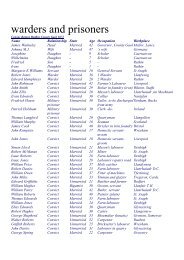pdf, 378.05 KB - Denbighshire County Council
pdf, 378.05 KB - Denbighshire County Council
pdf, 378.05 KB - Denbighshire County Council
You also want an ePaper? Increase the reach of your titles
YUMPU automatically turns print PDFs into web optimized ePapers that Google loves.
5 Roman Emperors to Welsh Princes: King Eliseg<br />
(c.750) and his Pillar at Valle Crucis<br />
Eliseg’s Pillar. © CADW.<br />
During the four centuries which followed the<br />
collapse of Roman government after c.A.D.400,<br />
Wales emerged as a separate nation. But<br />
exactly how this happened is shrouded in an<br />
obscurity illuminated only by half-historical<br />
legends, or by scattered clues from archaeological<br />
finds and worn inscriptions. Near the road from<br />
Llangollen to the Horseshoe Pass, not far from<br />
the medieval abbey of Valle Crucis, stands one<br />
of the most precious of these clues - the Pillar<br />
of Eliseg.<br />
Now a broken stump set on an ancient burial<br />
mound, the Pillar once stood some 20 feet (6.1<br />
m) high, topped by the cross which gave its<br />
name - ‘Valle Crucis’, ‘the vale of the cross’ - to<br />
this beautiful valley. On its shaft is a Latin<br />
inscription, now scarcely traceable and already<br />
fragmentary when it was copied down in 1696.<br />
It records that the Pillar was set up by Cyngen<br />
(d.854), the last independent King of Powys and<br />
southern <strong>Denbighshire</strong>, in memory of his<br />
great-grandfather King Eliseg. This Eliseg, the<br />
inscription declares, ‘annexed the inheritance<br />
of Powys - laid waste for nine years - out of the<br />
hands of the English with fire and sword’. In<br />
other words, he drove out the Anglo-Saxon<br />
invaders who continually threatened the Welsh<br />
borderlands, probably in about A.D.750. His<br />
victories may have led indirectly to the<br />
construction of Offa’s Dyke, the great border<br />
earthwork boundary a few miles to the east.<br />
Still more vital to historians is the inscription’s<br />
proclamation of Eliseg’s ancestry, stretching<br />
back across the ‘lost’ centuries to the Emperor<br />
Magnus Maximus (d.A.D.388), one of the last<br />
Roman rulers of Britain, and to his son-in-law<br />
Vortigern, the Romano-British ‘Great Lord’ who<br />
allegedly first invited Hengist’s Saxons into the<br />
land. The Pillar, however, records only that<br />
Vortigern was ‘blessed by St. Germanus’ (or<br />
Garmon), whose shrine stood a few miles to the<br />
north at Llanarmon-yn-Iâl, and who may have<br />
won a bloodless victory over the Saxons here in<br />
the Horseshoe Pass. Whether all this is actually<br />
true we may never know: what matters is that<br />
the Christian princes of early Wales believed<br />
themselves the true heirs of Rome.<br />
Places to visit<br />
Eliseg’s Pillar stands in a field to the right of the<br />
picturesque A542 road from Llangollen via the<br />
Horseshoe Pass to Ruthin. Valle Crucis Abbey<br />
(where parking is also available) is very well<br />
worth a visit, and the Pillar is only a short<br />
walk away.<br />
7




